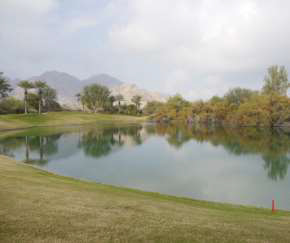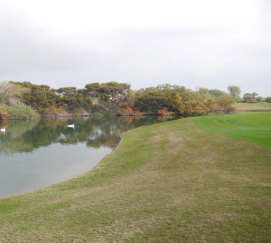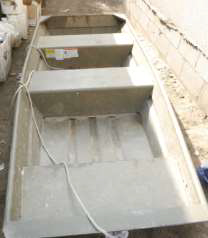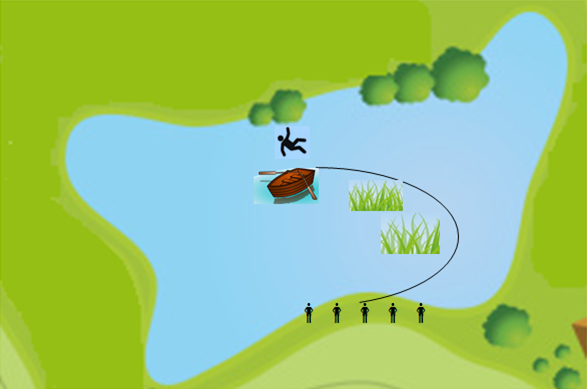Case Report: 15CA001
Lake maintenance worker drowns while removing weeds from a golf course lake
Download a PDF to print this report: Lake maintenance worker drowns while removing weeds from a golf course lake (15CA001, PDF)
Summary
A lake maintenance worker drowned after falling from a row boat while clearing vegetation (weeds) from a golf course lake. The victim worked for a lake management company. The victim was "corralling1" aquatic weeds by dragging a rope out into the lake, and circling the weeds while standing up in a 10-foot aluminum, non-motorized fishing boat. The movement in the boat caused it to capsize, throwing the victim into the water. The victim was recovered from the bottom of the lake six hours later by the sheriff's dive team. The victim was working alone in the boat, was not wearing a personal flotation device (PFD) and did not have proper training in hazard recognition or water safety. The California Fatality Assessment Control Evaluation (CA/FACE) program investigator concluded that, to help prevent similar incidents from occurring in the future, employers should:
- Provide personal flotation devices (PFDs) and ensure that workers wear them when working on water.
- Develop and implement a comprehensive, written Injury and Illness Prevention Program (IIPP) that includes training in hazard recognition and the avoidance of unsafe conditions when working on water and using small watercraft.
- Have two people on the boat when d oing work on water.
- Have life rings with ropes adequate in length to rescue workers who fall into the water or overboard.
- Provide proper equipment for operating small, non-motorized watercraft.
- Consider implementing an integrated pest management (IPM) program for controlling weed growth in lakes that includes a combination of mechanical, operational, biological, and chemical (herbicide) techniques, thus reducing the need for working from boats.
Introduction
On Tuesday, September 16, 2014, at approximately 1:45 pm, a 45-year-old male Hispanic lake maintenance worker drowned after falling from a boat while clearing vegetation from a golf course lake. On September 26, 2014, CA/FACE learned of the fatality through media reports. The CA/FACE investigator conducted an onsite investigation on December 17, 2014. During the site visit the CA/FACE investigator met with the employer, interviewed five witnesses, took photographs and observed the lake where the fatality occurred. The sheriff's report and coroner's report were also obtained.
Employer
The victim's employer was a lake management company that primarily services golf course lakes and some homeowner associations (HOAs). The company had been in business since 2008, and had eight employees. The company maintained golf course lakes by keeping them free of rubbish, algae and aquatic plants (macrophytes).2 At the time of the incident, the company was responsible for managing seven golf course lakes comprising over 300 surface acres of water. The company equipment and office were housed onsite at a large golf course complex.
Written Safety Programs and Training
The employer did not have an IIPP. Employees received safety training through weekly tailgate safety meetings and while on-the-job. According to the employees, these meetings did not include water safety training. At the time of the CA/FACE interviews, the employees had not been given training on water safety. The tailgate safety meetings were given in Spanish by the operations superintendent.
New employees did not go out in the boat until they gained experience with the other aspects of in-lake weed removal. There was no training provided on small craft safety. According to the employer, employees never worked alone around the water, and they were never trained to do so by the employer.
Worker Information
The victim was a 45-year-old Hispanic male lake maintenance worker who had been working for the owner for ten years, the first two years at another lake management company. His primary language was Spanish and he had a 6th grade education. He had lived in the United States for 14 years. His typical duties included application of lake related chemicals (e.g. herbicides, copper sulfate), trimming and removal of lake weeds, algae and dead fish, and cleaning basket filters.
Incident Scene
The incident scene was a 4.5-acre golf course lake (Exhibits 1 & 2). The lake served as an irrigation basin, receiving run-off water from an adjacent canal. Water from this lake flowed out through a pipe to another water feature on the course. Overgrowth of lake weeds and algae peak during the summer months. The lake was reportedly thick with weeds at the time of the incident.


Exhibits 1 & 2: View of lake where the fatality occurred (landscape view not to scale; photo taken when lake was free of vegetation).
Weather
The day was clear and warm, with a temperature of 101°F at the time of the incident; relative humidity was 33%, and winds were from the southeast at 11.5 miles per hour.
Equipment
On the day of the incident the victim was using the following equipment:
- 10-foot, square-nose, flat-bottom aluminum boat (Exhibit 3)
- Poled net, used as an oar (Exhibit 4)
- Rope to surround weeds


Exhibit 3. Boat used by victim. Exhibit 4. Poled net used for paddling the boat.
Investigation
On the day of the incident, the victim was working from a small boat while "corralling" weeds from a golf course lake maintained by the victim's employer. Corralling is an in-lake management method used for gathering floating weeds and moving them to the shoreline for disposal (Exhibit 5). During this procedure, a rope is attached to the boat and secured to the shore; the person in the boat takes the line out and surrounds the weeds in a large circular pattern and returns to shore. According to coworkers, the rope is allowed t o sink to the bottom, at which time the workers onshore pull the rope, extracting (culling) the underwater weeds, and bringing them closer to the shoreline where they can then be raked onto the shore for disposal.
On the day of the incident, the victim started w ork at 5:30 am. Throughout the day, the victim had made multiple passes in the boat, corralling in the weeds. At roughly 1:45 pm, the victim set out alone in the row boat to make one last pass at corralling the lake weeds before ending the work day. Five co-workers, who were all relatives of the victim, remained onshore to help with the removal and disposal of the weeds. The victim was paddling the boat from a standing position, using the poled net that is pictured above (Exhibit 4). He was about 90 feet offshore when t he boat overturned, causing him to fall into the water. The onshore workers saw the victim struggling in the water and one worker swam across the lake in an attempt to rescue the victim. When he reached the boat he saw the victim sinking; he pushed the boat toward the victim, but he was already underwater. The witness remarked that the dense vegetation made it difficult to move through the water and the water felt very heavy. Additionally, it was the end of a very hot work day and the witnesses reported being tired. Another worker entered the water and made it to the boat; two others then entered the water and made it halfway to the boat, threw a line to the two workers and pulled them and the boat back to shore. After approximately 10 minutes of searching/trying to rescue the victim, the workers called 911 for help.

Exhibit 5. Graphic depiction of corralling activity leading up to the fatal incident (not to scale).
Emergency medical service personnel arrived at the scene but could not locate the victim due to a lack of visibility in the lake and dense weed growth. The sheriff's dive team was dispatched and they recovered the victim at 8:03 PM. The water temperature was 88°F at the time the victim was recovered. The victim was found underwater, tangled in the weeds at a depth of 8 feet.
The victim was not wearing a PFD and there was no rescue equipment in the boat or onshore. Witnesses reported that the square-nosed boat that was being used that day may have contributed to the instability of the craft, leading up to the boat capsizing and the victim falling into the water. The boat involved in the incident was being used temporarily while their other boat was being repaired. The square-nose and shallow-hull design allows weeds to build up in front of the boat, impeding movement and requiring the boat operator to clear the weeds from the front of the boat, often from a standing position. Shifting one's weight in such a manner changes the center of gravity, decreasing stability. It was reported that the victim may have been clearing weeds from the boat's path when it overturned. There is inconsistent information as to whether the victim knew how to swim. During the CA/FACE interviews, the employer and witnesses reported that the victim knew how to swim. In contrast, information provided to the Sheriff's Department on the day of the incident indicated that the victim did not know how to swim.
Contributing Factors
Occupational injuries and fatalities are often t he result of one or more contributing factors or key events in a larger sequence of events that ultimately result in an injury or fatality. The CA/FACE team identified the following contributing factors in this incident that ultimately led to the fatality:
- Dense aquatic weeds
- Lack of safety equipment
- Lack of hazard recognition and training
- Lack of swimming ability
- Improper paddling equipment
- Hot weather conditions and worker fatigue
- No buddy system (two workers) on boat
Cause of Death
The cause of death according to the death certificate was drowning.
Recommendations
Employers with employees who regularly perform work in and around water should:
Recommendation #1: Provide PFDs and ensure that workers wear them when working on or near water.
Discussion: The victim was not provided with a PFD and did not wear one when he was working in the boat. The victim stood in the boat, maneuvered with a long pole and reached for the weeds. These activities pose a risk of capsizing the boat and falling overboard into the water. A U.S. Coast Guard-approved PFD (Type I, Type II, Type III) should be worn whenever employees are working on or near water where the danger of drowning exists (see
Title 8). In this incident, if the victim had been wearing an approved PFD, he may have remained buoyant for rescue and the drowning prevented.
Recommendation #2: Develop and implement a comprehensive written IIPP that includes training in hazard recognition and the a voidance of unsafe conditions when working on water and using small watercraft.
Discussion: In this incident, the victim was assigned the task of cleaning weeds from a lake by working in a boat relatively far from shore. He fell into the water, probably became tangled in the weeds, and drowned within minutes as rescuers were too far from shore. The employer did not have an IIPP that addressed water safety, and the victim had no specific training to work on the water safely. Employers should evaluate all tasks performed by workers, identify all potential hazards, then develop and implement a written safety program addressing these hazards. Training should be provided to employees about the hazards and safe work practices that apply to the work they are expected to perform. Training in recognizing and avoiding the potential hazards should be given to all workers. Employers should assess the competence of workers in their ability to swim and in recognizing hazards and using safe work practices around water, and should consider designating and providing training to a person competent in water safety and rescue (such as the American Red Cross basic water safety training). Additionally, training on the recognition and management of heat-related illness should be included when employees are likely to work in hot environments. If an appropriate hazard assessment had been done prior to removing the weeds in the lake, steps would have been taken to ensure the safety of the victim and prevented his death.
Recommendation #3: Have two people on the boat when doing work on water.
Discussion: The victim was alone in the boat and maneuvering in a standing position with a poled net to surround the weeds. In so doing, the boat probably became unstable and capsized. Whenever possible, work should be done from a sitting position. Having two persons in the boat when corralling weeds will help distribute the load more evenly, reducing the potential for capsizing. In addition, having a "buddy system" on the boat adds another level of safety in the event someone falls into the water, as a life ring can quickly be thrown to the person overboard.
Recommendation #4: Have life rings readily available for workers who work on or near water.
Discussion: When the victim fell onto the water, no life ring was provided by the employer or available at the time of the incident. The victim did not have any life ring to support his weight and prevent him from submerging under the water. A U.S. Coast Guard-approved, 30-inch life ring, with an attached line of at least 90 feet and 600-pound capacity, should be provided and accessible where the employees' work exposes them to the hazard of drowning (see
Title 8). Had a life ring been available to throw from the boat or from the shore, the victim's head might have remained above the water and the drowning prevented.
Recommendation #5: Provide proper equipment for navigating small non-motorized watercraft.
Discussion: The victim was using a long pole with a net (skimmer) as a means for propelling the boat through the water. This pole and/or the rope used to corral the weeds may have become caught on weeds, or contributed to the instability of the boat, causing it to capsize. Employers should provide proper equipment for navigating non-motorized watercraft. Using proper equipment, such as strong and adequately sized p addles or oars, helps with controlling and navigating small watercraft safely.
Recommendation #6: Consider implementing an integrated pest management (IPM) program for controlling weed growth in lakes that includes a combination of mechanical, operational, biological and chemical (herbicide) techniques, thus reducing the need for working from boats.
Discussion: The employer in this incident frequently used manual methods to control weeds in the golf course lake. This entailed deploying employees in small watercraft to capture the weeds and pull them in. The inherent nature of this method creates a risk of water entry by employees. Employers should consider using alternative methods to control lake weeds such as those described in
Footnote 1 (see
Biology and Control of Aquatic Plants). If these alternatives had been used in this incident, the victim would not have been out in a boat at risk of entering the water and drowning.
Footnotes
1 Coralling is an in-lake management method used for gathering floating weeds and moving them to the shoreline for disposal.
2 Macrophytes (henceforth referred to as lake weeds) consist of rooted and non-rooted floating plants (e.g. duckweed, water hyacinth), submerged plants which are rooted to the bottom (e.g. hydrilla, Eurasian watermilfoil), and emergent plants which are rooted along the shoreline, such as cattails. A variety of control methods exist for aquatic vegetation. These include the use of mechanical, operational, biological, and chemical (herbicide) tools. Mechanical methods include using harvesters or circulating pumps, corralling non-rooted plants and pulling them to the shore for removal, and cutting the roots of floating rooted plants and pulling them to the shore for removal. Biological techniques include the introduction of bacteria capable of using nutrients otherwise used by plants or degrading organic material. Operational tools include buffer strips to lessen fertilizer movement into the lake, and nutrient sequestration and dyes that limit resources to aquatic plants to lessen their vigor and rate of growth. Herbicide selection and use is plant-dependent and typically results in plant decomposition in the water.
References
Division of Occupational Safety and Health.
Title 8 regulations, Subchapter 7 - General Industry Safety Orders.
Group 2 - Safe Practices and Personal Protection.
Article 10. Personal Safety Devices and Safeguards,
§ 3389. Life Rings and Personal Flotation Devices.
§3395 Heat Illness Prevention. California Department of Industrial Relations
Division of Occupational Safety and Health.
Injury Illness and Prevention Program (IIPP). California Department of Industrial Relations
California Invasive Plan Council.
Aquatic Plants of the State of California (select a region and scroll down for recommended aquatic plants)
Aquatic Ecosystem Restoration Foundation.
Biology and Control of Aquatic Plants
American Red Cross Swimming and Water Safety Courses
Authors
Tracy Barreau, REHS, FACE Investigator
Robert Harrison, MD, MPH, FACE Project Officer
Laura Styles, MPH, Research Scientist
August 10, 2015